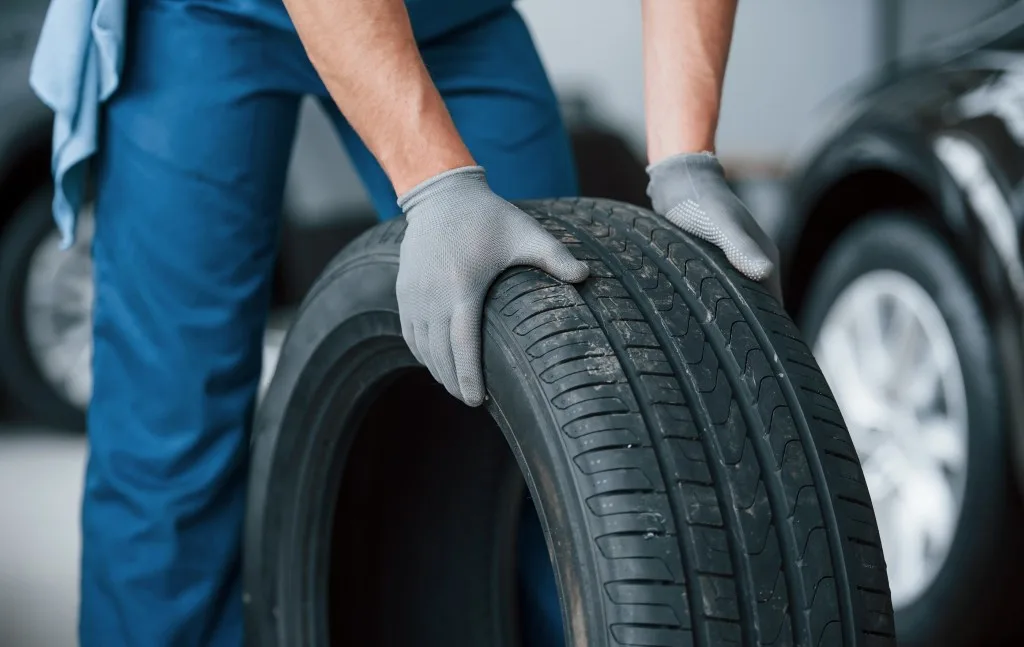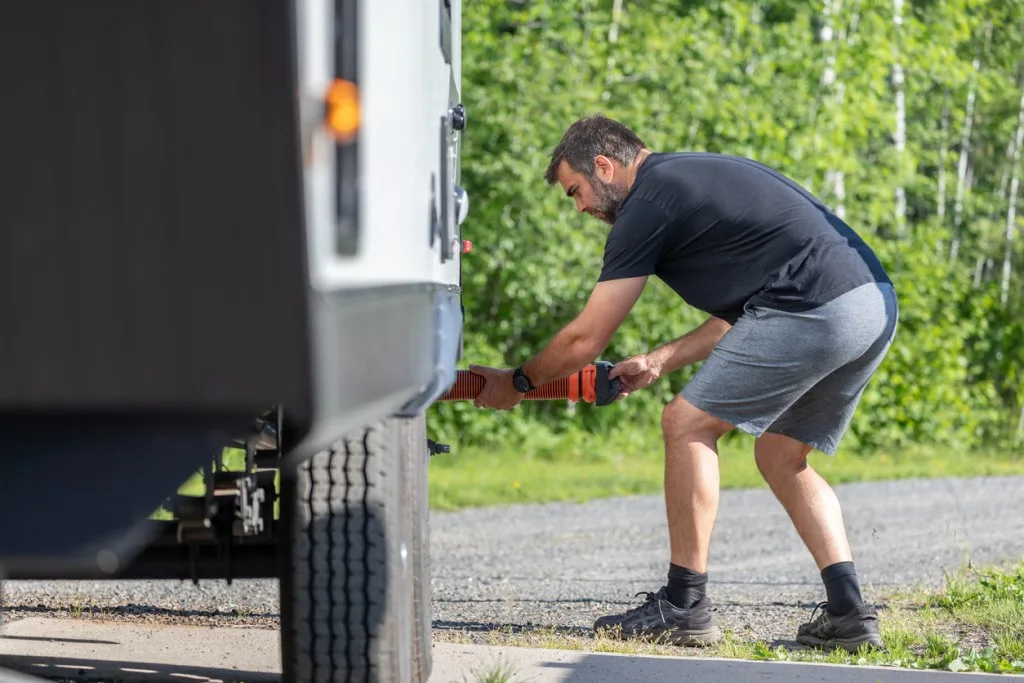Whether you RV full time or go on weekend adventures, you can quickly add hundreds of pounds of weight to your RV. It may cause you to ask, “Should I weigh my RV?”
It’s exciting to load up your RV and head to your favorite campground to make memories. When you pack camping chairs, firewood, and even s’more supplies, they’ll add weight to your RV.
Today we’ll share why pulling onto a scale may be more important than you might think.
Let’s get started!

Do You Really Need to Weigh Your RV?
While many RVers have never weighed their RV, it’s important to do it at least once. Knowing your RV’s weight can help ensure you don’t cause premature wear and tear to your RV or towing vehicle.
Why It’s So Important to Know Your RV Weight
There are several reasons why you should know your RV’s weight. You don’t want to drive across a bridge or road that has a maximum weight rating. You could either find yourself facing a ticket or a dangerous situation if you guess your weight.
Knowing your weight gives you an idea of how much gear and other items you can add to your RV. Adding too much weight can damage your RV’s axles and tires and cause issues while traveling down the highway. You don’t want to worry about these things, especially if you can easily avoid them.
Not knowing the weight of your RV also means not knowing if you’re within the towing specs of your vehicle. Pulling too much weight can cause wear and tear on your vehicle’s engine and suspension.
Too much weight on the rear axle can also cause you to lose traction on your front axle, which steers and controls your car.
Need to know: The 7 Deadly Sins of Trailer Towing

UVW, CCC, GAWR, and GVWR: What You Need to Know
RVs have many acronyms that you can easily confuse. However, you need to know what they mean for your unique towing setup.
Overloading your RV axles or vehicle can create unnecessary wear and tear on your essential suspension components on your RV and tow vehicle. A suspension problem means you’ll likely not get to tow your RV until you address the issue. Having a failure occur while towing can cause you to lose control and potentially cause an accident.
Exceeding your vehicle’s towing capacity will also cause your car to work harder and lead to issues with your engine, transmission, and other vital components. Your truck may handle the load once or twice, but you should plan to make friends with your local mechanic if you plan to do so regularly.
To avoid exceeding your tow ratings, you need to understand a few terms like UVW, CCC, GAWR, and GVWR.
UVW
UVW stands for unloaded vehicle weight. This is the weight of the RV at the factory with full fuel, engine oil, and any coolants. However, this number doesn’t include cargo, freshwater, propane, or dealer/customer-installed accessories. The UVW of a vehicle is what it weighs as it leaves the factory.
CCC
Another significant number is the CCC, which stands for cargo carrying capacity. This number is the difference between the unloaded vehicle weight (UVW) and what it weighs fully loaded. The CCC tells you how much weight you can add to your RV without violating the following substantial weight number.
GVWR
The GVWR is the gross vehicle weight rating, which is the maximum safe weight of an RV. This number includes solar panels, cargo, or liquids in your tanks. Knowing your GVWR helps you see whether you are within the manufacturer’s weight specifications and highway regulations.
GAWR
The final important term you should be familiar with is the GAWR. This stands for gross axle weight rating, which is the maximum amount of weight for each axle. Depending on the trailer or placement of the axles, the GAWR can vary from one to another.
How and Where to Weigh Your RV
While you can’t just place your RV on your bathroom scale, it’s not as inconvenient as you might think. Let’s take a look at how you can find scales to weigh your RV.
Truck Stop Scales
RVers aren’t the only ones worried about their vehicle’s weight. Truck drivers also have to ensure their rigs stay underweight to avoid an expensive ticket from the Department of Transportation.
Many chain truck stops like Flying J and Pilot commonly have scales for truck drivers, including RVers. You’ll typically see CAT scales. Find the nearest CAT scale on their website or by downloading their app.
You can easily weigh by pulling up to the scales, opening the app, and entering the location number when asked. Then position your RV onto the platform, and it will weigh each axle.
Make sure to place each axle on a different platform for the most accurate reading. A typical trip through a CAT scale will cost you $12, but you can get discounts if you re-weigh within 24 hours.
Escapees SmartWeigh
While CAT has over 1,400 across the country, Escapees manages three high-tech scales. They have a location in Florida, Texas, and Arizona. At each of these locations, they’ll give you personal attention to get the most accurate weight of your RV.
While truck stop scales will weigh each axle, these smart scales weigh each wheel. This helps ensure you have an evenly distributed load to know if your RV is balanced while rolling down the highway.
These great options provide a tremendous amount of data that you wouldn’t receive at a typical truck stop scale. You’ll also receive tips on how to remedy any balance or overweight issues.
As the Escapees SmartWeigh program involves more than just pulling onto a scale, it does require an appointment and costs $10 to $55, depending on your setup. Motorhomes and truck campers cost $45, while a towable RV and the tow vehicle cost $55.
Learn More: What is Escapees?
Dangers of an Overloaded RV
While you may want to load up your RV to the max for your trip, it can create a hazardous situation. Let’s take a look at what could happen if you overload your RV.
Tire Blowouts
Tires have a weight rating, and overloading your RV can push your tires over their limit. When you exceed a tire’s rating, it increases the friction between the tires and the road. This means your tires can heat up, which weakens the rubber and can lead to a blowout.
A tire blowout can do a tremendous amount of damage to an RV’s flooring and metal skirting. Many RVers have suffered significant damage, but it can also cause you to lose control and cause an accident.

Axle Failure
Overloading your RV means you might exceed the axle rating on your RV. Having an axle fail can cripple your rig. You’ll likely need a tow to the nearest repair shop to address the issue.
While you can carry a spare tire in case of a tire blowout, you’re likely going to have a more challenging time finding an extra axle or other suspension components.
Damage to Tow Vehicle
Overloading your travel trailer can cause damage to your tow vehicle as well, especially if it exceeds your tow numbers. You may not notice the damage at first, but overworking your truck can damage your engine, transmission, and other essential components.
Once problems start occurring with these components, they’ll likely worsen quickly. If you continue to push your vehicle to the limits, it will result in a significant failure. These types of repairs are expensive and likely not covered by a warranty.
Loading Weight Properly in Your RV
Not only do you want to make sure you don’t overload your RV, but also that you distribute the weight correctly. Let’s look at a few tips for properly loading your RV.

Keep the Weight Forward of the Back Axle
You want to keep the weight in front of the back axle. This is because putting too much weight behind the rear axle increases the chances of trailer sway. If you’ve never experienced trailer sway before, it can be a beast to handle.
You need to have control of your RV when going down the highway, not it controlling you. Putting excessive amounts of weight on bumper-mounted cargo baskets can also create an issue. If you notice a lot of sway, move any heavy items so they sit directly over the axles instead of behind them.
Evenly Distribute RV Weight from Side to Side
Not only do you want to distribute the weight from front to back, but also from left to right. Putting too much weight on one side of the RV means that those wheels can be taxed more than the others, leading to a potential blowout.
If you can’t take your RV to a smart weigh station, a less accurate way of fixing this is to inventory what items you have on each side of your RV. Food pantries, refrigerators, and storage bays can weigh an excessive amount. Try to distribute heavy items evenly from side to side.
Travel with Your Tanks Empty
A gallon of water weighs 8 lbs, some of the larger RVs have fresh tanks capable of holding 100 gallons of water. If you were to travel with a full fresh tank, that’s an extra 800 lbs. This will affect your gas mileage and overload your RV.
Liquids in your gray and black tanks add even more weight to your RV. If you have to travel with water in your tanks, try to empty them as soon as possible.

Weighing Your RV Is Essential for Safety
It’s easy to see that weighing your RV is essential to safety on the road. You need to weigh your RV whether you want to bring more on your weekend trip or if you need to downsize for full-time RVing. Don’t put it off any longer. Have you weighed your RV recently?
In 2023 It’s Easier than Ever
With new technology and RV Friendly truck stops, it’s easier than ever to weigh your RV. Please take our advice and weigh yours. It will give you peace of mind and protect you and others on the road.
Discover the Best Free Camping Across the USA
To be honest with you, we hate paying for camping. There are so many free campsites in America (with complete privacy).
You should give it a try!
As a matter of fact, these free campsites are yours. Every time you pay federal taxes, you’re contributing to these lands.
Become a FREE CAMPING INSIDER and join the 100,000 campers who love to score the best site!
We’ll send you the 50 Best Free Campsites in the USA (one per state). Access the list by submitting your email below: